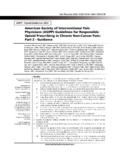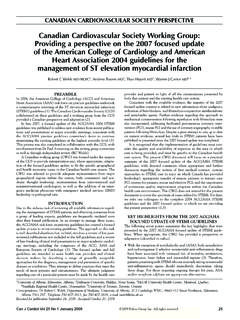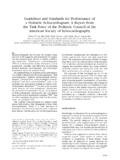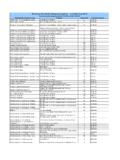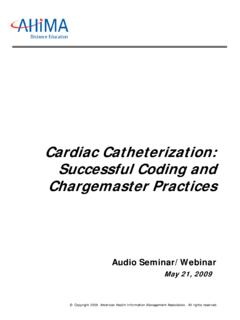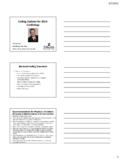Transcription of Exercise Treatment for Major Depression: …
1 ExerciseTreatmentforMajorDepression:Main tenanceofTherapeuticBenefitat10 MonthsMICHAELBABYAK, PHD, , PHD,STEVEHERMAN, PHD,PARINDAKHATRI, PHD,MURALIDORAISWAMY,MD,KATHLEENMOORE, PHD, , PHD, , PHD, , MDObjective:Thepurposeofthisstudywastoas sessthestatusof156adultvolunteerswithmaj ordepressivedisorder(MDD)6monthsaftercom pletionofastudyinwhichtheywererandomlyas signedtoa4-monthcourseofaerobicexercise, sertralinetherapy, :Thepresenceandseverityofdepressionwerea ssessedbyclinicalinterviewusingtheDiagno sticInterviewScheduleandtheHamiltonRatin gScaleforDepression(HRSD) ,after4monthsoftreatment,and6monthsafter treatmentwasconcluded(ie,after10months).
2 Results:After4monthspatientsinallthreegr oupsexhibitedsignificantimprovement;thep roportionofremittedpartici-pants(ie,thos ewhonolongermetdiagnosticcriteriaforMDDa ndhadanHRSD score!8) ,however,remittedsubjectsintheexercisegr ouphadsignificantlylowerrelapserates(p". 01) sownduringthefollow-upperiodwasassociate dwithareducedprobabilityofdepressiondiag nosisattheendofthatperiod(oddsratio" ,p".0009).Conclusions:Amongindividualswi thMDD,exercisetherapyisfeasibleandisasso ciatedwithsignificanttherapeuticbenefit, : depression , Exercise , "BeckDepressionInventory;DIS"DiagnosticI nterviewSchedule;DSM-IV"DiagnosticandSta tis-ticalManualofMentalDisorders,fourthe dition;HRSD"HamiltonRatingScaleforDepres sion;MDD"majordepressivedisorder;OR"odds ratio;SMILE"StandardMedicalInterventiona ndLong-TermEx-ercise(study).
3 Aerobicexercisehasbeenprescribedforthetr eat-mentofawiderangeofmedicaldisorders,i ncludingcardiovasculardisease(1,2),hyper lipidemia(3),os-teoarthritis(4),fibromya lgia(5),anddiabetes(6).Inaddition,exerci semayhaveanumberofpsychologicalbenefits( 7,8),andithasbeensuggestedasapotentialtr eatmentforavarietyofpsychiatriccondition s,espe-ciallydepression(9,10).Epidemiolo gicalstudieshaveshownaninverserelationbe tweenphysicalactivityandmentalhealth(11, 12).Ithasbeenshown,forexample,thatphysic alactivityisinverselyrelatedtodepressive symptoms(12,13)andthatindividualswhoincr easedtheiractivityovertimewereatnogreate rriskfordepressionthanindividualswhohadb eenphysicallyactiveallalong(14).
4 Moreover, (15 638(2000)0033-3174/00/6205-0633 Copyright 2000bytheAmericanPsychosomaticSocietyMET HODSP articipantsParticipantswerevolunteersage d50yearsandolderwhometDSM-IVcriteriaforM DD(22)andscoredatleast13ontheHRSD(23) ,participantsalsometthefollowingcriteria :1)notcurrentlytakingantidepressantmedic ation;2)notcurrentlyusingothermedication sthatwouldprecludetheirbeingrandomlyassi gnedtoeithermedicationorexerciseconditio ns(eg,quinidineormetoprolol);3)nocurrent problemwithalcoholorsubstancedependence; 4)nomedicalcontraindicationstoexercise(e g,significantorthopedicproblemsorcardiop ulmonarydiseasethatwouldpreventregularae robicexercise);5)noprimaryaxisIpsychiatr icdiagnosisotherthanmajordepression(eg,b ipolardis-orderorpsychosis);6)notimminen tlysuicidal;7)notcurrentlyinpsychotherap ythatwasinitiatedwithinthepastyear;and8) (20).
5 (24).SubjectswereconsideredtomeetDSM-IVc riteriaforMDDiftheyexhibitedeitherpersis tentdepressedmoodorlossofinterestorpleas ureplusthefollowingadditionalsymptoms:sl eepdistur-bance,weightlossorchangeinappe tite,psychomotorretardationoragitation,f atigueorlossofenergy,feelingsofworthless nessorexcessiveguilt,impairedcognitionor concentration,orrecurrentthoughtsofdeath , (23) , (25) ; ,participantswererandomlyassignedtooneof threetreatments:1)exercise2),medi-cation ,or3) (26), ,followedby30 (radialpulse) (Zoloft), (27).Medicationmanagementwasprovidedbyas taffpsychiatrist,whometwitheachpatientat thebeginningofthestudyandduringweeks2,6, 10,14, , usualcare guidelinesformedicationmanagement, ,HRSD,andBDIwerecon-ductedatbaseline,imm ediatelyafterthe4-monthtreatmentperiod,a nd6monthsaftertreatmentended(ie,10months afterstudyentry).
6 Allevaluationswereconductedinthehospital clinic, (28).Subjectswereclassifiedasbeinginfull remissioniftheynolongermetcriteriaforMDD andhadanHRSD score! #6months(ie,atthe6-monthfollow-upvisit). Aclassificationofpartialrecoverywasusedt odesignatesubjectswhodidnotmeetcriteriaf orMDDbutstillexhibitedsignificantdepress ivesymptomsasreflectedbyanHRSD score#7but! ! ,andbeforethecurrentlevelofdepressionwas assessed,participantswereaskedaboutthena tureandextentofanytherapeuticactivityeng agedinduringthefollow-upperiod, :aerobicexercise,weighttraining, ,ifatall,theyengagedinthatparticulartype ofexerciseandtheusualduration(inminutes) (20).
7 Briefly,inten-tion-to-treatanalysesshowe dthatthegroupshadsim-ilarremissionratesw ithrespecttopresenceorabsenceofcurrentMD D(p".67) , , !8wasaddedtotheclassificationscheme,ther atesofremissionwereagaincomparableforthe threegroups(p".58).Finally, :633 638(2000)mentsforinitiallevelsofdepressi onweremade,thegroupsstilldidnotdifferonH RSD(p".39)orBDI(p".40) (6-MonthFollow-UpVisit)Follow-upassessme ntswereavailableon133( ) (oneineachgroup) ( Exercise :N"9,17%;medication:N"6,13%;com bination:N"8,15%;p".89). ,self-reporteddepressivesymptoms(ie,BDIs cores)didnotvaryamongpersonsinitiallyass ignedtotheexercise(mean$SE" $ ),medication( $ ),orcombinedexerciseandmedication( $ )groups(p".)
8 13).However,wheninter-viewerratingsinwhi chthepresenceofMDDwasdefinedasthepresenc eofDSM-IVdiagnosisoranHRSD score#7wereused,itwasfoundthatpartici-pa ntsintheexercisegroupexhibitedlowerrates ofdepression(30%)thanparticipantsintheme dication(52%)andcombinedgroups(55%)(p".0 28). ,participantswerecategorizedasrecovered( noDSM-IVdiagnosisofMDDandanHRSD score!8for#6months),partiallyrecovered(n oDSM-IVdiagnosisofMDDandanHRSD score#7but!15),orrelapsed(presenceofDSM- IVdiagnosisofMDDregardlessofHRSD scoreoranHRSD score!15)(28).Toassesstherelationbetween treatmentandoutcomeclassification,apropo rtionaloddsregressionmodel,inwhichthethr ee-leveloutcome(fullrecovery,partialreco very,orrelapse)servedasthedependentvaria blewithbase-lineHRSD scorespecifiedasacovariate, ,withmedicationasthereferencegroup, ("2(2)" ,p".
9 016).Specifi-cally,participantsintheexer cisegroupweremorelikelythanthoseinthemed icationgrouptobepar-tiallyorfullyrecover edatthe6-monthfollow-upvisit(OR" ,p".01).Incontrast,patientsreceivingcomb inationtherapywerenomorelikelytobecate-g orizedaspartiallyorfullyrecoveredthanwer epa-tientsinthemedicationgroup(OR" ,p".57).Inaddition,only8%ofremittedpatie ntsintheexercisegrouphadrelapsed,compare dwith38%inthemedi-cationgroupand31%inthe combinationgroup( ). ,allpatientswereeducatedaboutMDDandweree ncouragedtocontinuewithsomeformoftreatme ntontheirown, ,48%ofparticipantsinthemedicationgroupin itiatedanexerciseprogramduringthe6-month follow-upperiod(p".
10 17).Thegroupsdifferedsignificantlyinthen umberofsubjectsusingantidepressantmedica tion,with40%ofsubjectsinthecombinationgr oup,26%inthemedicationgroup,and7%intheex ercisegroupreportingantide-pressantusedu ringthe6-monthfollow-upperiod(p".001).Tw enty-two(16%)oftheparticipantsenteredpsy chotherapyattheendofthe4-monthinterventi on(medication:N"7;combination:N"8;exerci se:N"7;p".99). (6monthsaftertreatment)amongpatientswhow ereremitted(N"83)after4monthsoftreatment inExercise(N"25),Medication(N"29),andCom bination(N"29) , :633 638(2000)or1(nooryes),andexercisewasquan tifiedasthenumberofminutesperweekofaerob icexercise,scaledtoincrementsof1SD(about 50minutes).
